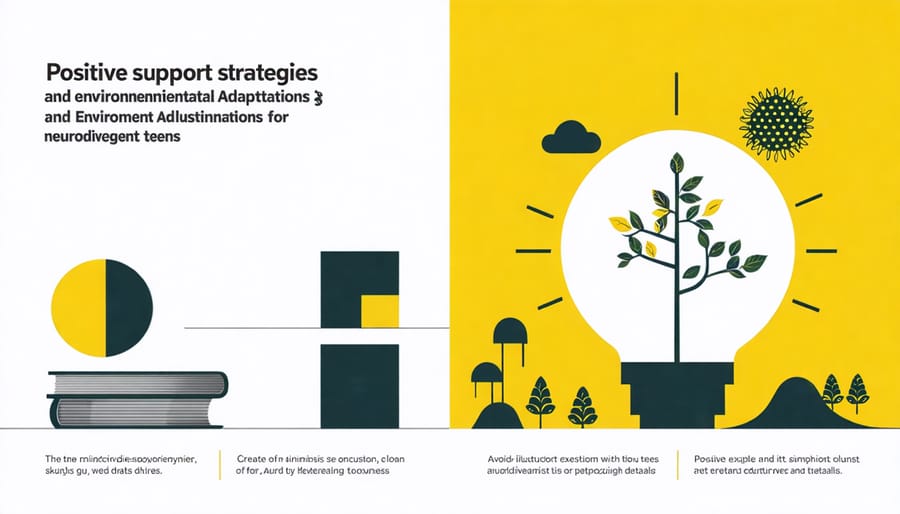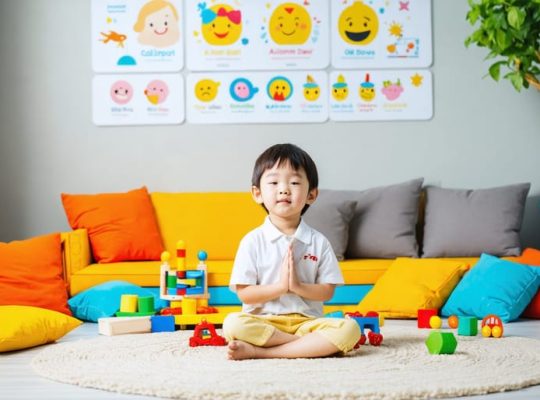Understanding neurodevelopmental disorders like ADHD and autism spectrum disorder (ASD) fundamentally shapes how we support young people in their journey of self-discovery and identity formation. These conditions, affecting millions of children worldwide, present unique challenges and opportunities in cognitive development, social interaction, and emotional regulation.
While ADHD and ASD manifest differently in each individual, both conditions significantly influence how children perceive themselves and interact with the world around them. ADHD typically impacts attention, impulse control, and executive functioning, while ASD affects social communication, behavioral patterns, and sensory processing. Together, they represent two of the most commonly diagnosed neurodevelopmental conditions in childhood, often persisting into adolescence and adulthood.
Recent research highlights the critical importance of early identification and intervention, not just for managing symptoms but for supporting healthy identity development. Parents, educators, and healthcare providers play crucial roles in creating supportive environments that celebrate neurodiversity while addressing specific challenges these conditions present.
This exploration will delve into how ADHD and ASD shape personal identity, examining evidence-based strategies for fostering self-acceptance, building resilience, and promoting positive development in children with these neurodevelopmental differences.
Understanding ADHD in Adolescence

Key ADHD Characteristics
ADHD in teenagers presents through three primary characteristics: inattention, hyperactivity, and impulsivity. These traits can significantly impact daily life, though they may manifest differently in each individual. Many teens experience difficulty maintaining focus during classes or homework, often struggling with executive function challenges that affect their ability to organize tasks and manage time effectively.
Inattention might show up as frequent daydreaming, losing important items, or having trouble following multi-step instructions. Some students may appear to be listening but struggle to retain information, while others might hyperfocus on activities they find engaging while neglecting other responsibilities.
Hyperactivity often presents more subtly in teens than in younger children. Instead of running around, teens might feel restless during quiet activities, fidget constantly, or talk excessively. They may have difficulty sitting still during meals or lectures, preferring to stay in motion whenever possible.
Impulsivity can manifest as interrupting others, making quick decisions without considering consequences, or engaging in risky behaviors. Teens might blurt out answers before questions are completed or struggle with waiting their turn in conversations or activities.
It’s important to remember that these characteristics exist on a spectrum, and with proper support and understanding, teens with ADHD can develop effective strategies to manage their symptoms and thrive in both academic and social settings.
Impact on Social Development
Children with ADHD often face unique challenges in their social development in adolescence, particularly when forming and maintaining friendships. Many experience difficulties reading social cues, taking turns in conversations, or managing impulses during peer interactions. These challenges can affect their self-esteem and how they view themselves within their social circles.
Sarah, a child psychologist with 15 years of experience, shares: “I’ve observed that children with ADHD often struggle with maintaining long-term friendships because they may interrupt conversations or have difficulty staying focused during social activities. However, with proper support and understanding, they can develop meaningful relationships.”
The impact on social identity formation can be significant. Children might feel different from their peers or struggle to fit in with social groups. They may experience:
– Difficulty joining group activities
– Challenges in reading body language and facial expressions
– Trouble maintaining conversations
– Impulsive responses that could affect friendships
However, it’s important to remember that with appropriate support systems in place, children with ADHD can develop strong social skills and positive self-identity. Parents and educators can help by:
– Creating structured social situations
– Teaching specific social skills through role-play
– Encouraging participation in activities that align with the child’s interests
– Providing positive reinforcement for successful social interactions
These strategies can help children build confidence and develop the social skills needed for healthy relationships throughout their lives.
Autism Spectrum Disorder in Teen Years
Autism’s Core Features
During adolescence, autism’s core features often become more noticeable as social demands increase. Young people with autism typically experience challenges in three main areas: social interaction, communication, and behavior patterns.
In social interactions, teens may find it difficult to interpret facial expressions, understand social cues, or maintain reciprocal conversations. They might struggle with establishing and maintaining friendships, despite having a genuine desire to connect with peers. Many autistic adolescents feel most comfortable with structured interactions and may need support in navigating the complex social dynamics of teenage life.
Communication patterns in autistic teens can vary widely. Some may have advanced vocabulary but struggle with the nuances of conversation, like taking turns or understanding sarcasm. Others might find it challenging to express their emotions or needs verbally. Non-verbal communication, such as body language and tone of voice, can be particularly difficult to interpret and use effectively.
Behavioral characteristics often include repetitive movements, intense interests in specific topics, and a need for routine and predictability. During adolescence, these traits may become more pronounced as teens face new situations and increased expectations. Many autistic teens also experience sensory sensitivities, which can make typical teenage environments like crowded cafeterias or noisy hallways particularly challenging.
Understanding these core features helps parents and educators provide appropriate support while celebrating each teen’s unique strengths and abilities.
Social Integration and Self-Concept
Children with autism often experience unique challenges in developing their social understanding and self-concept. Their distinctive autism communication patterns can make it harder to form friendships and navigate social situations, which in turn affects how they view themselves and their place in the world.
Dr. Sarah Chen, a child development specialist, explains: “Many autistic children process social information differently. They might struggle to read facial expressions or understand unspoken social rules that their peers seem to grasp naturally. This can impact their confidence and sense of belonging.”
However, it’s important to remember that every child’s experience is unique. Many autistic individuals develop strong, positive identities based on their special interests and abilities. Take Marcus, a 12-year-old with autism who found his social confidence through a robotics club: “When I’m working on robots, I can be myself. The other kids understand me because we speak the same language of engineering.”
Supporting positive identity development involves creating accepting environments where autistic children can:
– Express themselves authentically
– Connect with others who share their interests
– Develop social skills at their own pace
– Celebrate their unique perspectives and abilities
– Build on their natural strengths
With appropriate support and understanding, autistic children can develop strong self-concepts and meaningful social connections while embracing their authentic selves.

Supporting Identity Development

Creating Supportive Environments
Creating a supportive environment is crucial for children with neurodevelopmental disorders to thrive. Start by establishing predictable routines and clear expectations, which help reduce anxiety and promote a sense of security. Visual schedules, quiet spaces, and organized learning areas can make a significant difference in daily functioning.
Dr. Sarah Chen, a child development specialist, emphasizes: “The goal is to create spaces where children feel understood and accepted for who they are, not spaces where they’re constantly trying to fit in.”
Consider sensory needs by managing noise levels, lighting, and physical comfort. Some children may benefit from noise-canceling headphones, fidget tools, or weighted blankets. Others might need movement breaks or alternative seating options to stay focused and comfortable.
Foster inclusion by educating peers and family members about neurodevelopmental differences. Celebrate diverse ways of thinking and learning, highlighting each child’s unique strengths and abilities. Remember that what works for one child may not work for another – flexibility and observation are key.
Encourage open communication between home, school, and healthcare providers. Regular check-ins help identify challenges early and ensure consistent support across all environments. Most importantly, maintain a positive, accepting attitude that acknowledges progress and effort rather than focusing solely on challenges.
Create opportunities for success by breaking tasks into manageable steps and providing appropriate accommodations without making children feel different or singled out.
Building Self-Advocacy Skills
Developing self-advocacy skills is crucial for teenagers with neurodevelopmental disorders as they navigate their way through adolescence. These skills empower them to understand and effectively communicate their needs, challenges, and strengths to others.
Start by helping teens identify their unique needs and challenges. Create a simple list or journal where they can record situations that feel challenging and what specific support would help. This process builds self-awareness and helps them articulate their experiences more clearly.
Encourage practice in safe environments, such as role-playing conversations with family members before having similar discussions with teachers or peers. Teach specific phrases and communication strategies they can use, such as “I learn better when…” or “I need extra time to…”
Dr. Sarah Chen, a developmental psychologist, suggests: “When teens understand their rights and can express their needs confidently, they’re better equipped to succeed in school and social situations. It’s like giving them a voice they can use effectively.”
Remember that building these skills takes time and patience. Celebrate small victories, like when your teen successfully requests accommodations or advocates for themselves in class. This positive reinforcement builds confidence and encourages continued growth in self-advocacy abilities.
Provide ongoing support while gradually stepping back to allow more independence. This balance helps teens develop their own voice while knowing they have a safety net of support when needed.
Promoting Positive Self-Image
Building a positive self-image is crucial for children with neurodevelopmental disorders. Parents and caregivers can play a vital role by focusing on their child’s unique strengths rather than their challenges. Start by celebrating small victories and acknowledging progress, no matter how minor it may seem.
Create opportunities for success by breaking down tasks into manageable steps. When children experience achievement, even in small doses, it helps build their confidence and reinforces positive self-perception. For example, if a child struggles with organization, praise them for keeping their desk tidy for one day rather than expecting perfectly maintained organization all week.
Dr. Sarah Chen, a child psychologist, emphasizes the importance of honest, age-appropriate discussions about neurodiversity. “Help children understand that their brain works differently, not wrongly,” she explains. “This understanding can transform their self-perception from feeling ‘broken’ to feeling uniquely capable.”
Encourage children to connect with peers who share similar experiences through supervised support groups or social activities. These connections help normalize their experiences and create a sense of belonging. Additionally, expose children to positive role models who have similar conditions and have achieved success in various fields.
Remember to validate their feelings while helping them develop coping strategies. Use affirming language that separates the child’s identity from their challenges: “You have ADHD” rather than “You are ADHD.” This distinction helps maintain a healthy self-image while acknowledging their unique needs.
Understanding and supporting teens with neurodevelopmental disorders is crucial for their healthy identity development and overall well-being. As these young people navigate the already challenging waters of adolescence, they need a strong support system that recognizes their unique strengths while acknowledging their challenges.
Parents, educators, and healthcare providers play vital roles in helping these teens develop positive self-images. By focusing on their capabilities rather than limitations, we can help build their confidence and self-worth. Remember that every teenager with ADHD or autism is unique, with their own dreams, interests, and potential.
Creating accepting and inclusive environments at home, school, and in social settings allows these teens to explore who they are without fear of judgment. When we celebrate their differences and provide appropriate accommodations, we send a powerful message that they are valued members of our community.
Early intervention, consistent support, and open communication can make a significant difference in how teens with neurodevelopmental disorders view themselves and their place in the world. By helping them develop strong self-advocacy skills and connecting them with peer support networks, we empower them to embrace their identities and navigate life’s challenges with confidence.
Together, we can help create a more understanding and supportive world where teens with neurodevelopmental disorders can thrive and develop into confident, capable adults who are proud of who they are.



